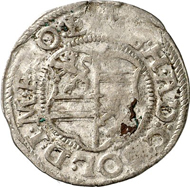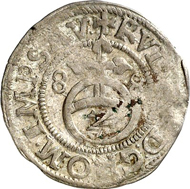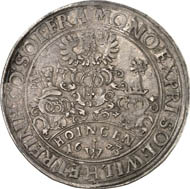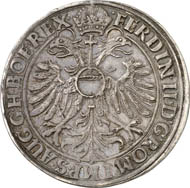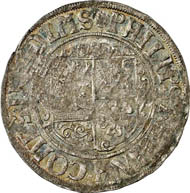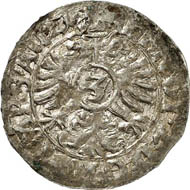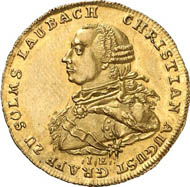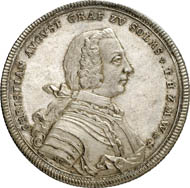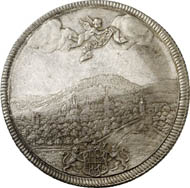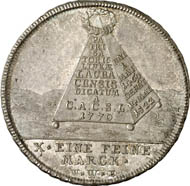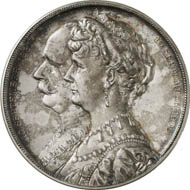They had their territory expanded quite a bit, those belonging to the Hesse noble house of Solms, whose name the records mentioned for the first time in 1129. From their ancestral seat at Solms Castle they had secured the control over the middle Lahn valley where an important trade route was situated back then which connected the imperial cities of Frankfurt, Wetzlar and Cologne.
As did every imperial prince and knight, the lords of Solms, too, faced the fact in early Modern times that the yields from their own territory didn’t run to the increasing demands anymore. Thus, the aim was to find money otherwise. The imperial service was profitable and provided the opportunity to collect privileges for one’s own house at the court of the emperor.
Family tree of those lineages of the House of Solms that played a role in minting.
Already Philip zu Solms had served Maximilian I and Charles V as imperial council. His son had the choice of either joining the reformation and consequently get his hands on lavish means due to the expropriation of monasteries or, rather, to continue serving the emperor and fight the princely opposition. Reinhard zu Solms decided in favor of the emperor. He had become one of the leading experts in the art of fortification and rendered services to the expansion of the most important fortifications of his day. In 1546, Emperor Charles V appointed him field marshal, and in 1552, he granted him the minting privilege. Reinhard zu Solms died in 1562 as imperial council without ever having exercised the right.
Solms-Lich. 1/2 batzen 1588, Lich, with title of Rudolph II. 1.14 g. Joseph 22 s. From auction Künker 212 (June 19, 2012), 4001. Estimate: 20 euros. This piece was minted in cooperation by the sons of Count Reinhard I, the brothers Ernst I, Eberhard and Hermann Adolph.
That was changed by his sons and grandsons. They had produced mainly small change for the local market, which brought more profit out of the seigniorage than the representative gold and heavy silver coins that were much fewer in number. The Tipper and See-Saw Time brought a change when anyone who possessed the right to mint coins could make a fortune.
Solms-Lich. 1/2 batzen 1594, Lich, with title of Rudolph II. 1.19 g. Joseph 54 g. From auction Künker 212 (June 19, 2012), 4003. Estimate: 20 euros. This piece was minted jointly by the sons of Count Reinhard I, the brothers Eberhard and Hermann Adolph as well as the four sons of late Count Ernest I, Reinhard II, George Eberhard, Ernest II and Philip.
Forced by the high expenditures in the war against the Winter King in Prague, the Habsburgs had reduced the silver content of their coins to such an extent that the non-debased coins of their neighbors couldn’t cope with them. They, too, began to produce coins of lesser value to finance their expenses at a grossly overrated nominal value. Thanks to the prerogative of coinage the princes had the right to confiscate the not-yet-debased coins on the markets they controlled only to melt and then re-issue them.
Solms-Hungen and Solms-Greifenstein. Reichstaler 1623, Hungen, on the alleged Hungen yield. 28.66 g. Dav. 7743. Example from the Paul Joseph Collection. From auction Künker 212 (June 19, 2012), 4249. Estimate: 4,000 euros. Minted by Wilhem von Solms-Greifenstein and Reinhard von Solms-Hungen.
Anyone lacking the prerogative of coinage could trick anyway, like Wilhelm zu Greiffenstein and his brother Reinhard von Hungen. Being members of the Solms-Braunfels lineage they didn’t have the prerogative as such, but utilized the turmoil of the 30 Years’ War to appropriate it. Everything was as it should be, formally. The inscription on the coins clearly said …EX PRI(mitiis)…, meaning from the first yield. According to the Imperial Minting Ordinance the owner of the mines had the right to produce their own coins from the silver yields they made. The only stain was the fact that there was no mine whatsoever on the territory of Wilhelm and Reinhard that could have brought the yield in the first place. They tipped the scales as well and took the not-yet-debased coins out of circulation to produce ones of minor value. Naturally, the emperor didn’t put up with that in the long run. A charge was filed. The courts back then, however, worked even more slowly than the modern ones. It is highly likely that the charges were dropped when Wilhelm von Greiffenstein died in 1630.
Solms-Hohensolms. Kipper-12-kreuzer (dreibätzner) 1620, Niederweisel, with title of Ferdinand II. 3.74 g. Joseph 218 d. From auction Künker 212 (June 19, 2012), 4049. Estimate: 200 euros.
The other counts of Solms likewise took part in this profitable business. Philip Reinhard I, for example, of the Solms-Hohensolms lineage was forced in 1620 to close down his mint in Niederweisel because it had fallen into disrepute due to the issuing of grossly debased coins.
Kipper-3-kreuzer 1621, Butzbach, with title of Ferdinand II. Joseph 226 l. From auction Künker 212 (June 19, 2012), 4052. Estimate: 25 euros. Minted by Count Philip Reinhard I.
The new mint in Butzbach, however, continued that fraud. Mintmaster Hans Jakob Ayrer was officially regarded the one responsible. He was arrested in Frankfurt in 1622 when he – very probably by the Count’s order – tried to change coins of lesser value for non-debased ones. When his accommodations were searched, kipper coins worth more than 5,000 gulden were found.
Solms-Laubach. Ducat 1761, Hanau. 3.48 g. Joseph 449. From auction Künker 212 (June 19, 2012), 4204. Estimate: 5,000 euros.
After 1700, only the Solms-Laubach lineage continued minting. Christian August (1738-1784) had his house praised with magnificent, baroque heavy silver coins issued on various princely occasions:
Reichstaler n. d. (1738), Nuremberg, on his accession to power. 29.21 g. Joseph 445. From auction Künker 212 (June 19, 2012), 4196. Estimate: 3.000 euros.
Wedding, birth and death, ancestors and successors.
Konventionstaler 1770, Wertheim, on Count Otto, founder of the Solms-Laubach line. 28.07 g. Joseph 456. From auction Künker 212 (June 19, 2012), 4221. Estimate: 1,500 euros. Minted by Count Christian August, 1738-1784.
The subjects revolve around the noble family.
Solms-Baruth. Silver medal 1906 by R. Otto on the Silver Wedding of Prince Friedrich, 1904-1920, with Louise, Countess von Hochberg, on September 10. From auction Künker 212 (June 19, 2012), 4245. Joseph 464. Estimate: 100 euros.
The history of the coins from Solms dies out with some medals, since in 1806 the princely family of Solms met the same fate as many other mediatized princes in the empire. As a consequence of the German Mediatization, their territories were incorporated into the bigger principalities. Whereas there had been several hundreds of immediate territories in 1806, only 34 were left after that date.
Henceforth, those of Solms were allowed to call themselves mediatized princes. Until the European Revolutions they continued to exercise the jurisdiction in their former territories, were exempt of taxes and had a permanent seat in the first chamber of their state parliament. Despite of the political activities many still found the time to act as sponsor in sciences and arts, like Karl von Solms-Hohensolms-Lich (reigning 1899-1920).
He was a keen coin collector who assembled the collection of Solms coins which the Künker Company has the pleasure of presenting in auction catalog 212 on June 19, 2012. Prince Karl supported the publication of the monograph “Die Münzen und Medaillen des fürstlichen und gräflichen Hauses Solms” written by Paul Joseph whose collection he likewise acquired.
There is more to German history than the biographies of some emperors. The ensemble offered at Künker is a marvelous illustration of the fate of one of the many princely families that shaped the German Empire for centuries.
You will find all objects of auction 212 on the Künker website.





